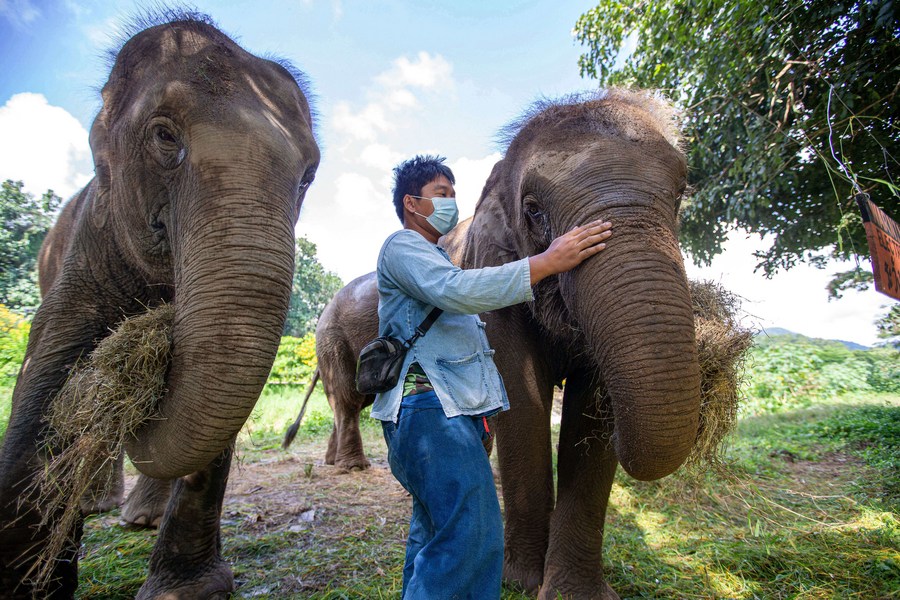News
Vets Working to Protect Elephants in Northern Thailand

The Thai Elephant Conservation Center is home to more than 100 Asian elephants on 320 hectares, in northern Thailand’s Lampang province. The conservation center is also a research center and is at the forefront of treating sick pachyderms in Thailand.
Having treated thousands of elephants, veterinary officer Taweepoke, however, cannot forget an injured elephant bearing a sharp pain in the dense bush 20 years ago.
“His two front legs were broken. I could do nothing but feed him a pain reliever. We were not able to move him out from the deep jungle, neither did we have the medicine or equipment on-site to save him from dying,” said Taweepoke.
Facing the world’s largest land animal, the vet has seen the situation being slowly improved since then.
“We are trying to provide medicine and treatment for elephants with preventable disease and injuries in the jungle,” said Taweepoke who is now the head of Thai Elephant Conservation Center.
100 Asian elephants
Covering an area of 320 hectares, the state-owned reserve is home to more than 100 Asian elephants in northern Thailand’s Lampang province. It’s a center for research and is at the forefront of treating sick elephants in Thailand.
In addition to an on-site hospital, elephants in distress are treated by a mobile clinic and rescue unit wherever they may be in the kingdom. As most domesticated elephants’ health problems result from mahout’s improper practices, the center also set up a mahout training school.
“We started from a small clinic with a leaky roof and a few medical boxes 27 years ago. With every help call, we set off never quite knowing what we would find and whether we could make a satisfactory treatment. It’s exciting, scary, and distressing,” said Taweepoke.
The vet called the job an adventure. “You never know what’s around the corner in the remote jungle, especially dealing with a giant pachyderm. Sometimes you have to hide in a tree to keep yourself from its attack, and sometimes you have to stay there for a week just to treat the badly wounded until it can walk. I love the moment when I successfully save an elephant’s life, it’s wonderful.”
Only Female Veterinarian
“There is no specific subject on elephant study at the universities. Research in this area is far behind those on cats and dogs. Thailand is home to more than 7,000 elephants, while there are about 20 elephant vets around the country.”
Warangkhana is one of the 20 and the only female vets in Lampang’s elephant center. The 35-year-old has been working in the mountain and forests for 11 years after completing a six-year veterinary science degree.
With the help of mahouts, Warangkhana began her day by putting up a black cloth on wooden stakes to shelter her animal patient from the scorching sun. After injecting saline solution into the 82-year-old pachyderm, she started to clean the wounds on the pachyderm’s feet.
The female elephant was badly hurt after being collided by another one. She suffered from osteoarthritis and was not able to walk. The wrinkled animal has been treated here for several years.
“It’s teamwork. Treating an elephant is never an easy job. For human beings or pets, we can use medical equipment. But it seldom works on a plodding pachyderm,” said Warangkhana.
No elephant veterinary manual
She still remembered her first patient in the deep jungle. The wild elephant fell into a stream and suffered a severe injury on its spine while fighting with another.
“It took hours to reach that remote jungle to locate the elephant. We camped there for four days and set up a clinic, trying our best to make the elephant able to walk. But finally, it died. It really hurt me,” she said.
“Each failed rescue effort is a precious lesson. There is no elephant veterinary manual,” the vet recalled with pity in her eyes. “It’s all about passion and experience. Just think about I managed to rescue hundreds of the world’s biggest land animals. That’s cool and it makes me continue.”
Warangkhana thanked all the Thais who love and care for elephants, saying the animal is a source of cultural identity for Thailand throughout its history.
“We see people care for the animal not only in Thailand but also in Asia including China. When the famous herd of wandering elephants finally headed home in southwest China’s Yunnan province, people evacuated to make way for them and gave them food. It’s lovely. It shows how people love and respect life,” said the female vet.
Source: Xinhua
































